Intel Broadwell Xeon E3-1200 v4 - all you need to know about the new line of Xeon and eDRAM
Intel recently unveiled an updated line of new Intel Broadwell Xeon E3-1200 v4 quad-core processors. A series of server processors Intel Xeon E3-1200 v3 appeared on the market in the 2nd quarter of 2013 and was quietly updated in the second quarter of 2014 on the model type E3-1231 v3. Now announced Xeon v4. We will understand: what does Intel offer us?
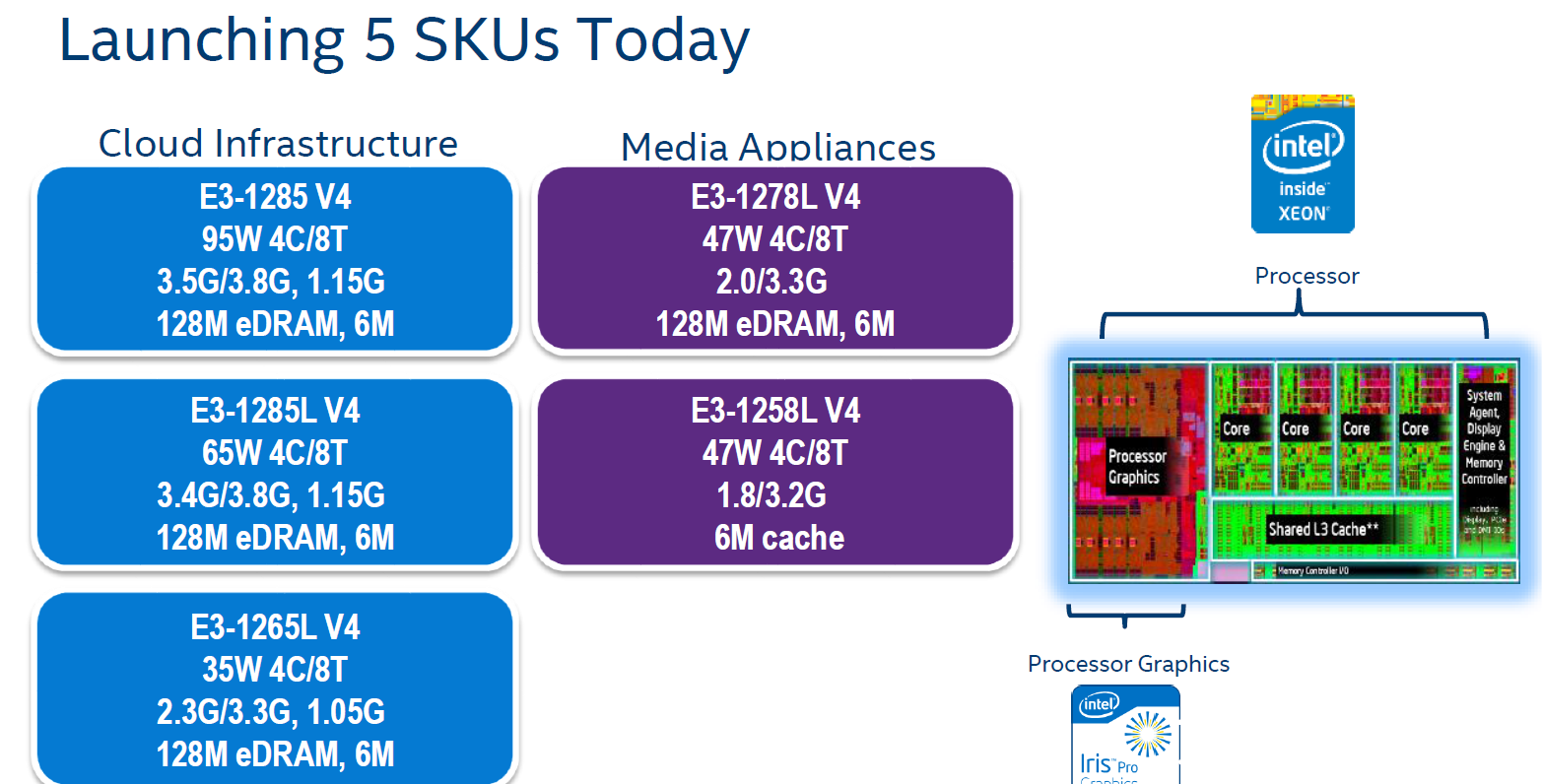
In terms of tick-to-tack strategy, Broadwell is “tick”: the manufacturer used Haswell architecture in 14-nanometer version. "Tick" does not imply a revolutionary change. Analysts believe that in this phase Intel will finish the known technologies, and the improvements will be cosmetic. According to the specification, Broadwell provides lower power consumption and comparable overall performance to previous generation processors.
Consider three new server processor Intel Xeon E3-1200 v4 socket LGA 1150.
The third-level cache is truncated by 2 MB, that is, a quarter compared to previous Xeon models. As www.anandtech.com notes, the loss of 2 MB of L3 is insignificant, considering the appearance of a 128 MB eDRAM in L4.
')
In early 2007, Intel and IBM, together with AMD, Toshiba and Sony, almost simultaneously announced a technology that will speed up the work of processors by half. For this, it was proposed to use eDRAM memory (embedded DRAM), which will be used in conjunction with the silicon-on-insulator technology (SOI, Silicon-on-Insulator). IBM said that this would significantly speed up the cache, increase its density by three times and reduce power consumption by five times in idle mode. Then it was planned to use a cache of 24 MB.
Technologically embedded DRAM is DRAM, embedded (“embedded”) in a processor as opposed to SDRAM. The eDRAM requires a voltage of 1 V, which is noticeably lower than the power supply of conventional memory. In practice, this means that eDRAM consumes less energy, providing comparable performance. Smaller eDRAM cells — 0.108um² for SRAM and 0.029um² for eDRAM — will fit an order of magnitude larger than slightly slower memory cells onto an chip of the same size.
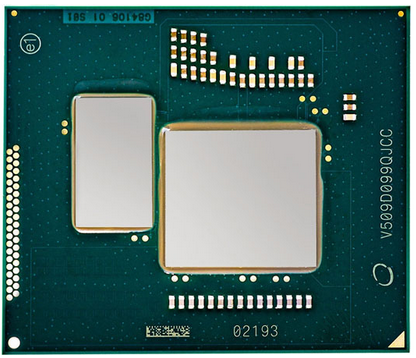
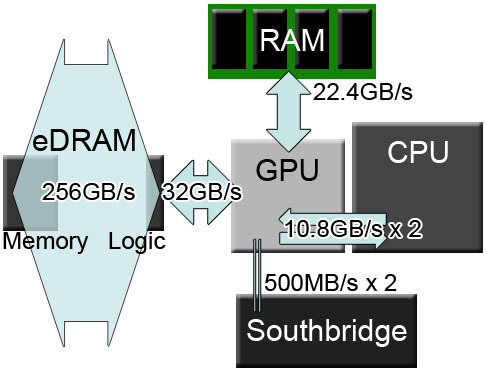
Intel not only put the famous Haswell on 14-nanometer rails. In Broadwell processors, the manufacturer used the capabilities of eDRAM as fully as possible today. The manufacturer claims a 25% improvement in parameters such as power consumption and heat dissipation.

The 128MB Crystalwell eDRAM crystal plays the role of a fourth-level cache. Haswell had such a cache, but only in the top E7 models. At the same time, the eDRAM can be used by both the graphics core and the processing cores of the processor when processing large amounts of data, such as textures. According to the manufacturer, Crystalwell provides peak bandwidth of 51.2 GB / s in each direction (102.4 GB / s in total).
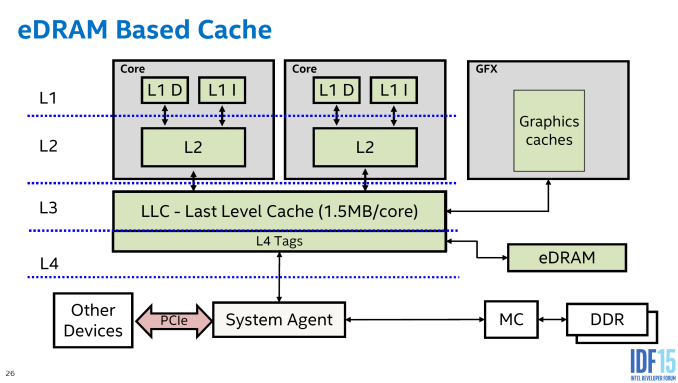
According to tests conducted by 3Dnews.ru , the latency of the e4- based L4 cache is 55 clocks, and the throughput is approximately twice as high compared to dual-channel DDR3-1866 SDRAM.
Crystalwell allows the processor to overcome the relative limitations of low bandwidth system memory and show the best performance in tasks for processing HD-video and mathematical operations.
According to Intel's own tests (Supermicro SuperServer was used), while using Broadwell it is possible to simultaneously process 4368 HD video streams. The same figure when using Haswell processors is 3120. There is an increase in performance by 40%. All motherboards S upermicro X10 series support v4 after updating the BIOS.
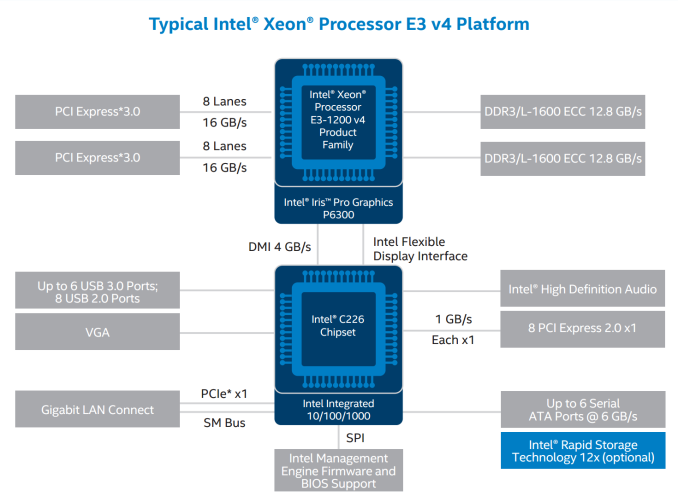
The new line of processors used the graphics core Iris Pro Graphics , the “lightweight” version of which was previously found only in Haswell mobile processors. Now Iris Pro Graphics P6300 has a GT3e configuration and 48 execution units (EU, execution units) versus 40 EU in Haswell Pro Graphics Graphics 5100 and 5200 cores.
The use of Iris Pro Graphics P6300 is also a significant difference between the new Xeon and the Xeon E3-1200 v3 on Broadwell: in the previous line, the less advanced Intel HD Graphics P4600 and Intel HD Graphics P4700 were used.
The clear advantage of the processors under consideration is that they are installed in the LGA1150 slot: owners of motherboards based on the Intel Z97 and Intel H97 chipset can easily upgrade the system. Formally, the new Xeon is compatible with motherboards based on the eighth series chipset on the LGA1150 socket.
Users upgrading from Haswell to Broadwell can now do so relatively cheaply. So, if Intel recommended prices for E3-1285L v3 are $ 774, then the cost of E3-1285L v4 is $ 445.
The disadvantage for some users may be the impossibility of overclocking these processors. However, this Xeon series is a server solution, and the manufacturer offers other processors of the new line to overclocking fans.
In a number of tests conducted by www.anandtech.com , Intel Broadwell Xeon E3-1200 v4 processors showed inconsistent results.
When archiving 2867 files with a total volume of 1.52 GB, E3-1285L v4 showed the best result, overtaking even more powerful E3-1285 v4.
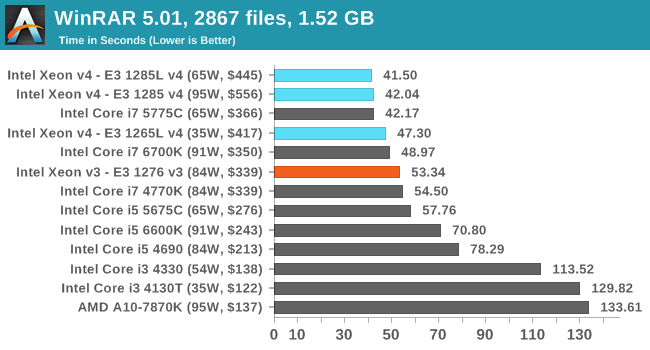
However, in other tests, the Xeon lagged behind the competition. Converting a series of 170 images using FastStone Image Viewer v.4.9 turned out to be quite a challenge for the new Xeon.

The launch of the Dolphin gaming console emulator showed that in working out the 3D scenes of the Intel Broadwell Xeon E3-1200 v4, only weak processors are ahead.
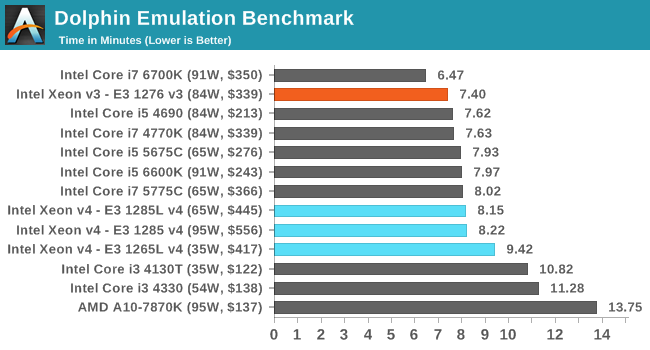
At the same time, when converting x264 video to mp4, Broadwell only lagged behind the Intel Core i7 6700K.

The line of Intel Broadwell Xeon E3-1200 v4 processors thanks to the use of the new eDRAM memory chip overtakes the old models in solving heavy computational problems and processing HD video at reduced values of power and heat release.
1) high-performance graphic stations
2) dedicated servers performing transcoding and streaming tasks without using a Tesla-type GPU. New Intel processors show 40% of the performance on such tasks and reduce the cost of hardware transcoders. Here is a comparative table of performance for Wowza online broadcast products - which processors are suitable for which tasks.
2) dedicated servers allowing to virtualize graphical applications - for this purpose it was necessary to install Tesla or something like that before
 We at Hostkey offer dedicated servers for rent in Moscow and the Netherlands - we will have a new type of processors for virtualizing 3D applications and streaming / video processing at the beginning of 2016.
We at Hostkey offer dedicated servers for rent in Moscow and the Netherlands - we will have a new type of processors for virtualizing 3D applications and streaming / video processing at the beginning of 2016.
For such tasks, we recommend customers to use multi-core Xeon processors of older series, for example, a machine in a 2x Xeon E5-2670 v2 configuration with 20 cores at 2.5 GHz based on the T-Platform supercomputer platform and 32GB of memory will cost 23,000 rubles per month .

In terms of tick-to-tack strategy, Broadwell is “tick”: the manufacturer used Haswell architecture in 14-nanometer version. "Tick" does not imply a revolutionary change. Analysts believe that in this phase Intel will finish the known technologies, and the improvements will be cosmetic. According to the specification, Broadwell provides lower power consumption and comparable overall performance to previous generation processors.
Consider three new server processor Intel Xeon E3-1200 v4 socket LGA 1150.
| CPU | Xeon E3-1285 v4 | Xeon E3-1285L v4 | Xeon E3-1265L v4 |
| Kernels / Threads | 4/8 | 4/8 | 4/8 |
| Hyper-Threading Technology | there is | there is | there is |
| Clock frequency | 3.5 GHz | 3.4 GHz | 2.3 GHz |
| Maximum frequency in turbo mode | 3.8 GHz | 3.8 GHz | 3.3 GHz |
| Unlocked multiplier | Not | Not | Not |
| Tdp | 95 W | 65 W | 35 W |
| HD graphics | Iris Pro P6300 | Iris Pro P6300 | Iris Pro P6300 |
| Graphics core frequency | 1150 MHz | 1150 MHz | 1050 MHz |
| L3 cache | 6 MB | 6 MB | 6 MB |
| Integrated eDRAM | 128 MB | 128 MB | 128 MB |
| DDR3 support | 1333/1600/1866 | 1333/1600/1866 | 1333/1600/1866 |
| VPro / TSX-NI / TXT / VT-d technologies | there is | there is | there is |
| Instruction set extensions | AVX 2.0 | AVX 2.0 | AVX 2.0 |
| Socket | LGA1150 | LGA1150 | LGA1150 |
The third-level cache is truncated by 2 MB, that is, a quarter compared to previous Xeon models. As www.anandtech.com notes, the loss of 2 MB of L3 is insignificant, considering the appearance of a 128 MB eDRAM in L4.
')
What is eDRAM?
In early 2007, Intel and IBM, together with AMD, Toshiba and Sony, almost simultaneously announced a technology that will speed up the work of processors by half. For this, it was proposed to use eDRAM memory (embedded DRAM), which will be used in conjunction with the silicon-on-insulator technology (SOI, Silicon-on-Insulator). IBM said that this would significantly speed up the cache, increase its density by three times and reduce power consumption by five times in idle mode. Then it was planned to use a cache of 24 MB.
Technologically embedded DRAM is DRAM, embedded (“embedded”) in a processor as opposed to SDRAM. The eDRAM requires a voltage of 1 V, which is noticeably lower than the power supply of conventional memory. In practice, this means that eDRAM consumes less energy, providing comparable performance. Smaller eDRAM cells — 0.108um² for SRAM and 0.029um² for eDRAM — will fit an order of magnitude larger than slightly slower memory cells onto an chip of the same size.


Intel not only put the famous Haswell on 14-nanometer rails. In Broadwell processors, the manufacturer used the capabilities of eDRAM as fully as possible today. The manufacturer claims a 25% improvement in parameters such as power consumption and heat dissipation.

The 128MB Crystalwell eDRAM crystal plays the role of a fourth-level cache. Haswell had such a cache, but only in the top E7 models. At the same time, the eDRAM can be used by both the graphics core and the processing cores of the processor when processing large amounts of data, such as textures. According to the manufacturer, Crystalwell provides peak bandwidth of 51.2 GB / s in each direction (102.4 GB / s in total).

According to tests conducted by 3Dnews.ru , the latency of the e4- based L4 cache is 55 clocks, and the throughput is approximately twice as high compared to dual-channel DDR3-1866 SDRAM.
Crystalwell allows the processor to overcome the relative limitations of low bandwidth system memory and show the best performance in tasks for processing HD-video and mathematical operations.
According to Intel's own tests (Supermicro SuperServer was used), while using Broadwell it is possible to simultaneously process 4368 HD video streams. The same figure when using Haswell processors is 3120. There is an increase in performance by 40%. All motherboards S upermicro X10 series support v4 after updating the BIOS.

Video core Iris Pro Graphics
The new line of processors used the graphics core Iris Pro Graphics , the “lightweight” version of which was previously found only in Haswell mobile processors. Now Iris Pro Graphics P6300 has a GT3e configuration and 48 execution units (EU, execution units) versus 40 EU in Haswell Pro Graphics Graphics 5100 and 5200 cores.
The use of Iris Pro Graphics P6300 is also a significant difference between the new Xeon and the Xeon E3-1200 v3 on Broadwell: in the previous line, the less advanced Intel HD Graphics P4600 and Intel HD Graphics P4700 were used.
The clear advantage of the processors under consideration is that they are installed in the LGA1150 slot: owners of motherboards based on the Intel Z97 and Intel H97 chipset can easily upgrade the system. Formally, the new Xeon is compatible with motherboards based on the eighth series chipset on the LGA1150 socket.
Users upgrading from Haswell to Broadwell can now do so relatively cheaply. So, if Intel recommended prices for E3-1285L v3 are $ 774, then the cost of E3-1285L v4 is $ 445.
The disadvantage for some users may be the impossibility of overclocking these processors. However, this Xeon series is a server solution, and the manufacturer offers other processors of the new line to overclocking fans.
Tests
In a number of tests conducted by www.anandtech.com , Intel Broadwell Xeon E3-1200 v4 processors showed inconsistent results.
When archiving 2867 files with a total volume of 1.52 GB, E3-1285L v4 showed the best result, overtaking even more powerful E3-1285 v4.

However, in other tests, the Xeon lagged behind the competition. Converting a series of 170 images using FastStone Image Viewer v.4.9 turned out to be quite a challenge for the new Xeon.

The launch of the Dolphin gaming console emulator showed that in working out the 3D scenes of the Intel Broadwell Xeon E3-1200 v4, only weak processors are ahead.

At the same time, when converting x264 video to mp4, Broadwell only lagged behind the Intel Core i7 6700K.

Summing up
The line of Intel Broadwell Xeon E3-1200 v4 processors thanks to the use of the new eDRAM memory chip overtakes the old models in solving heavy computational problems and processing HD video at reduced values of power and heat release.
What are they needed for:
1) high-performance graphic stations
2) dedicated servers performing transcoding and streaming tasks without using a Tesla-type GPU. New Intel processors show 40% of the performance on such tasks and reduce the cost of hardware transcoders. Here is a comparative table of performance for Wowza online broadcast products - which processors are suitable for which tasks.
2) dedicated servers allowing to virtualize graphical applications - for this purpose it was necessary to install Tesla or something like that before
 We at Hostkey offer dedicated servers for rent in Moscow and the Netherlands - we will have a new type of processors for virtualizing 3D applications and streaming / video processing at the beginning of 2016.
We at Hostkey offer dedicated servers for rent in Moscow and the Netherlands - we will have a new type of processors for virtualizing 3D applications and streaming / video processing at the beginning of 2016.For such tasks, we recommend customers to use multi-core Xeon processors of older series, for example, a machine in a 2x Xeon E5-2670 v2 configuration with 20 cores at 2.5 GHz based on the T-Platform supercomputer platform and 32GB of memory will cost 23,000 rubles per month .
Source: https://habr.com/ru/post/266519/
All Articles